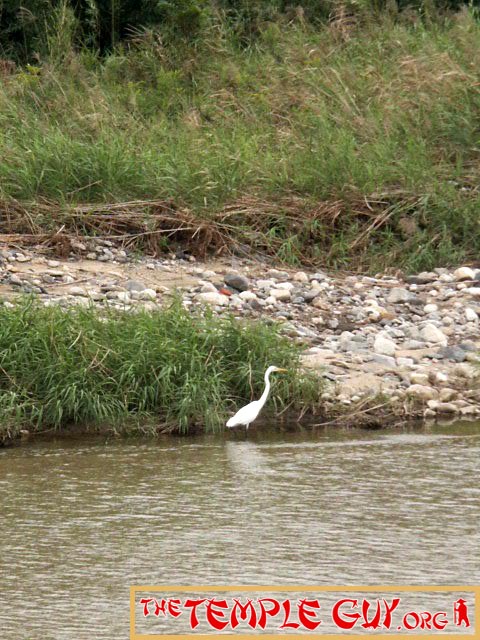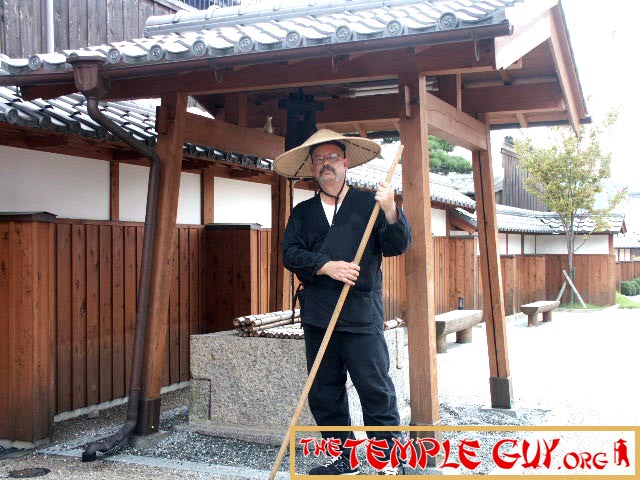Friday, October 5, 2001 (click to see all posts from this day)
|
Yeah. Almost Tsuchiyama. But not because I wanted to. Because that's where the bus was. Read on.
I left Nagoya in the morning and returned to last night's stopping point, just before entering Kameyama.
Kameyama, Station #46 on the Old Tokaido
I found Kameyama to be a friendly and attractive small town. There was a castle there, and what's left of it is between the elementary school and the junior high. I imagine these facilities were located on the former castle grounds when it was razed.
After strolling a small shopping street, I followed the route marked by the town (which differed considerably from the one on my map). This led me towards the castle remains. On the way, however, next to the elementary school, I saw these men--presumably volunteers--doing some excavation. I wonder what these holes were?
Approaching the castle, one sees this monument--to what, I don't know--framed in autumn colors.
The castle itself is just a single building, a replica of a yagura or watchtower.
However, this view downward of one corner of the fortifications shows that the town probably spent a lot of money to reconstruct this one building! (There was also a shrine on the grounds down below with some more replication, but this was the only dramatic part.)
By the way, Kameyama is said to have a samurai's mansion, but as it is open by reservation only, I didn't seek it out.
And here, in front of the one building, is my official shot for Kameyama, station number 46 on the Old Tokaido.
Hiroshige's Tokaido: Kameyama, Station #46 on the Old Tokaido
Much is made of this print because Hiroshige is famous for his snow scenes. We're definitely in the mountains here (as the names of this and several succeeding stations show; yama means "mountain" and saka means "slope"). So the snow is likely. But, as before, HIROSHIGE IS A BIG, FAT LIAR. There is no slope even remotely like this to be seen. |
Moving out of Kameyama, I encountered this really good ichirizuka.
Also, I saw this little drama I call "Life and Death on the Old Tokaido."
The route leads up the valley of the Suzuka River, toward the dreaded Suzuka Pass. Here is the river at full bore...
...and a heron walking the banks. For a long time--kilometers, it seemed--any time I got close, he flew farther up river. Finally, the road was far enough away that he didn't feel threatened, and I got this shot with my lens "doubler."
Seki, Station #47 on the Old Tokaido
On to Seki. This place was a real treat, at least on the eastern edges. Look at this streetscape, with the mountains beyond! It was very moving. But nearing the center of town, the place became a tourist circus, despite some rather odd omissions.
Mainly what I mean is, that although Seki (as its name says) was one of the three main sekisho or barriers on the Old Tokaido, there is not even a replica of a barrier there now, as there is at Hakone and Arai. This construction project near the west end of town may be a barrier replica, but the construction worker I quizzed about it just kept smiling and shaking his head like I was speaking Swahili.
But there were some special treats. Like this: it must be Japan's most historic bank!
And these: probably the best cutouts I've seen. (Send me a couple of faces and a donation, and I'll send you this picture with the faces in it.)
Or this: the best cliche shot of "Old and New Japan" since the Shinkansen (bullet train) in front of Mount Fuji.
By the time I got into town, the place was so jammed with tourists that it was hard to find a place for my official shot. I finally ducked into a small park located on the site of a former shop, complete with its own well in the (former) courtyard. No one seemed to fancy this place, so I got the shot in peace.
Hiroshige's Tokaido: Seki, Station #47 on the Old Tokaido
Proof that the barrier was still there in his day (unless he lied again). |
Sakanoshita, Station #48 on the Old Tokaido
Tramping onwards--and oh so gradually upwards--I reached Sakanoshita, the gateway to Suzuka Pass. Its name means "at the bottom of the slope."
There is almost no "there" there (to steal a phrase). Not a store or shop. A few historic markers, though. And a small temple named Hoanji, which stole pieces from the old inn for the daimyos (lords). This is my official shot, standing under the stolen gate.
I also said your prayers here, plus a little prayer for myself as I headed for the Pass.
Hiroshige's Tokaido: Sakanoshita, Station #48 on the Old Tokaido
The mountain in the distance is Mount Fudesute, "Mount thrown away brushes." It is said that the painter Kano Motonobu threw away his brushes in despair at being unable to capture the beauty of this craggy pile of rocks and pines. (One wonders what it was called before his disappointment.) |
There are so many stunning mountains in the area that I couldn't pick out which one was Fudesute-san.
At Sakanoshita, there is a Folk Song Hall, dedicated to materials related to this song: "The sun shines and shines on the slope, but Suzuka is clouded, and rain is falling at Ai no Tsuchiyama." Ladies and gentlemen, this is no joke. At four-something in the afternoon, it was dark on Suzuka Pass. This is the closest I've come to being scared on this whole trip. A nameless fear was creeping up on me, and I had to fight it down consciously. It was as dark as after six for no apparent reason. The trail was washed out; a brief stretch of ishidatami--stone paving--was slick and mossy. This shrine along the way seemed deserted.
My shot of the pass itself is shaky--not because I quaked with fright, but because it was so dark.
Apparently, these people haven't heard about the 400th anniversary of the Old Tokaido; this sign looks like it's been there for awhile, and it was the only signage on the pass.
But on the other side? The trees are gone, and tea plantations prevail. The city of Tsuchiyama has built a nice restroom and park, with this giant lantern (which commemorates something, but I couldn't read what; any volunteers?).
It's a pleasant walk down; little did I know what trouble lay ahead.
Tsuchiyama, Station #49 on the Old Tokaido (but not yet officially)
It was nice to see this sign, because I missed the entry to Mie prefecture (since I took the train as a substitute for the old ferry); though I don't suppose there would have been a sign at the border that I could see from the ferry, either!
I imagine that in days past, the women of the area used to meet at the well on the left to collect their water and talk over the recent news. Do you think they meet now when they collect their aluminum cans? It's interesting to me how often public space remains public; perhaps the city's trash area has always been "common ground" because of the well.
It's about six kilometers from the pass to the first bus stop. (Buses seem to come up from both sides, but I couldn't find any that went over the pass except in the early morning.) I was making good time, enjoying the scenery, I even had a sunset to wrap up the day.
And then.
I got to the stop; 50 minutes 'til the next bus. OK, I can deal with that. Entertain myself. It's a dark, dark place. Read the names on the passing buses and trucks. Wait. Wait. Ah! Here it comes! AND.....THERE IT GOES!
I know he saw me. My hand was raised. He even started to pull over...then swerved away. I guess we had a problem with body language. And it was almost an hour until the next bus! 6:40! And I'm kilometers and kilometers from home.
To make a long story short, the next bus--and last bus of the night--stopped. I had moved down to the next stop, a bit better well-lit. I got a train, then another train, then a shinkansen, then a subway. I got to the youth hostel in Nagoya at 10:55--too late for a bath! YUK!
--------
But there is a bright spot in all this. When the last bus stopped, I sounded off--humorously but directly--about the previous driver not stopping. This driver was dumbstruck. I'm cold, I said; I'm tired, I'm hungry, etc., etc.
So at the station, the first thing he did was refuse my 900 yen (big secret, don't tell anyone, he could get fired). As I left the bus, he asked me to wait a moment in the station. A few minutes later, he came into the station, followed by his wife and child--it was the end of shift, and they had come to pick him up--and presented me with two onigiri, the popular "rice balls" that are the Japanese equivalent of a sandwich. They're something you can make (or buy) to take along.
I was really touched. I don't know if this was from his lunch, or something his wife had brought to tide him over 'til they got home--I don't know.
But let me tell you: for that nearly-an-hour wait, I was beyond angry. I was seething, in a rage. I was so angry, I was feeling physically sick--adrenaline poisoning. I tried walking, screaming (it was a country place), praying, doing anything I could to dissipate this murderous rage. I wasn't even angry at the driver who passed me per se; it was more the situation, and my fatigue.
But this simple act of kindness by the driver who stopped--the sharing of "bread"--wiped it away in an instant, and nearly brought me to tears. (As I'm actually writing this on Saturday night, I can tell you now: tune in tomorrow, there's a sequel.)
So, as I said, home, no bath, no time to write, utter exhaustion.
And it's the first day of my second month on the road; I set out on September 5th. Seems like years ago.
| ← Previous Day | Back to Old Tokaido Guide | Next Day → |
Posted October 5, 2019



























No comments:
Post a Comment